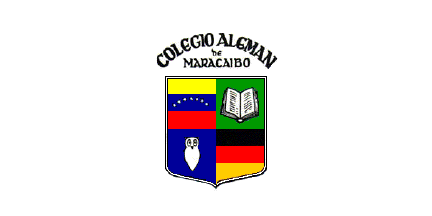
image by Ivan Sache, 8 November 2010

Last modified: 2014-11-08 by zoltán horváth
Keywords: venezuela | university |
Links: FOTW homepage |
search |
disclaimer and copyright |
write us |
mirrors
See also:
Other Sites:

image by Ivan Sache, 8 November 2010
Colegio Alemán de Maracaibo started in 1926 as Colegio Alemán (German School),
the first foreign - but not restricted to the German community - school in
Maracaibo. Closed in 1942, the institute was reinstated in 1952 as Colegio
Alemán del Zulia, eventually renamed on 7 January 1967 Colegio Alemán de
Maracaibo. The institute is managed by the non-profit association Deutscher
Schulverein Maracaibo (Maracaibo German School Association).
The flag of Colegio Alemán de Maracaibo, as shown graphically on the
institute's website, is white
with the coat of arms of the institute in the middle.
The coat of arms of Colegio Alemán de Maracaibo is "Quarterly, 1. A Venezuelan
flag, 2. Vert an open book argent, 3. Azure an owl argent, 4. A German flag."
The name of the institute is written in black letters above the shield. The
Venezuelan flag is shown here with seven stars, while having been added another
star in 2006; whether the institute's coat of arms and flag was updated
accordingly, or not, is unknown to me.
Source:
http://www.cam.edu.ve/simbolos.htm
Ivan Sache, 8 November 2010

image by Ivan Sache, 03 July 2014
Colegio Eugenia Ravasco was established in 1978 in Los Chorros borough
(Caracas) by the Congregation of the Daughters of the Holy Hearts of Jesus and
Mary. Founded in 1868 by the Italian nun Eugenia Ravasco (1845-1900; beatified
on 27 April 2003 by Pope John Paul II), the congregation settled in Venezuela in
1951, where they are best known as the Ravasco Sisters.
The flag of the institute is yellow with the emblem of the congregation in the
middle, formed of two adjacent shields:
- left, a yellow shield charged with the two red Sacred Hearts of Jesus and
Mary;
- right, a blue shield with a yellow leopard and two yellow bends, symbolizing
the power of the Ravasco family.
Source:
http://www.colegioeugeniaravasco.edu.ve/bandera_colegio.asp - Institute's
website
Ivan Sache, 03 July 2014
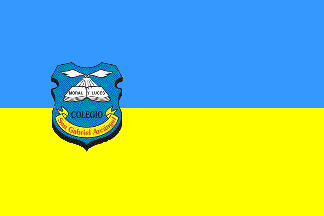
image by Ivan Sache, 13 July 2014
Colegio San Gabriel Archangel was established in 1977 in Valencia (Carabobo
State) by Ana María Torreiro de Pérez and Esteban Pérez Poza. Originally named
Jardín de Infancia El Niño Jesus and located in the Camoruco borough, the
institute was renamed Complejo Educativo Colegio San Gabriel Archangel in 1982,
when transferred to the Valles de Camoruco borough. The institute is named for
Archangel Gabriel, the name being also a tribute to Gabriel Pan, benefactor and
instigator of the institute.
The symbols of the institute were designed by its founders, Ana María Torreiro
de Pérez and Esteban Pérez Poza.
The flag is horizontally divided blue-yellow with the institute's emblem placed
near the hoist. Blue is a symbol of highness and an invitation to love God and
the neighbour. Blue is a also a symbol of thought, dedication and
conscience. Yellow is a symbol of spiritual wealth and of light.
The emblem features:
- two wings, representing Archangel Gabriel, the protector of the
institute and of its community;
- light rays, which provide guidance;
- a book, representing science, knowledge, investigation, and discovery, charged
with the institute's motto, "MORAL Y LUCES" [Moral and Enlightenment];
- a yellow scroll inscribed with the institute's name in red letters.
Source:
http://www.sangabrielarcangel.org/index.php/features/menu-options -
Institute website
Ivan Sache, 13 July 2014

image by Ivan Sache, 13 July 2014
Instituto Técnico Jesús Obrero (ITJO) was established in 1948 by the Society
of Jesus in the Catia borough (Caracas), where the Jesuits had erected a chapel
in 1941; in 1948, Father Dionisio Goicoechea established Escuela Virgen de los
Dolores, subsequently transformed into a technical school aimed at teaching
technical jobs to worker's ["obreros"] children.
The flag of the institute is diagonally divided white-red by a blue bend charged
with "I.T. JESUS / OBRERO" in white letters. In the middle is placed the
institute's emblem.
The emblem of the institute is a white shield with a blue border charged with
the institute's motto "DIOS PATRIA HOGAR TRABAJO" [God Homeland Home Work] in
white letters. The shield is charged with a red anvil superimposed to a blue
cogwheel and superimposed by a yellow Christian cross surrounded by the yellow
letters "JO". The shield is surrounded by green branches, omitted on the flag.
Source:
http://www.cerpe.org.ve/instituto-tecnico-jesus-obrero-catia.html -
Institute's webpage
Ivan Sache, 13 July 2014
The flag and coat of arms of the education institue Liceo
Bolivariano "Hilario Pizani Anselmi", located in
Motatán, shall be selected on 12 May 2006. The selection process
started on 11 May 2006 with the presentation of 38 flags and 38
coat of arms, one by section of the institute. For the second
round, 12 flags and 12 coats of arms have been kept.
Source: <www.diarioeltiempo.com.ve>.
Ivan Sache, 13 May 2006
On July 18, 2010 I found the flag of the UBV (Universidad Bolivariana de
Venezuala):
- image:
http://www.ubv.edu.ve/images/stories/simbolos/Bandera.gif (website:
http://www.ubv.edu.ve/index.php?option=com_content&view=article&id=86&Itemid=45)
It is the first public University established in the last decade in Venezuela,
in 2003.
Source:
http://es.wikipedia.org/wiki/Universidad_bolivariana_de_venezuela
Esteban Rivera, 15 August 2010

image by Guillermo T. Aveledo , 21 December 1999
Universidad Central de Venezuela (Central University of
Venezuela; founded 1721).
Description: A white field (although sometimes light yellow or
even beige are used; there are no official specifications to this
flag besides the ones I'm giving) with the Seal of the University
and the date "1721" (date it was founded) on royal blue
(embroidered under the seal on roman type letters). The seal
consists of a few Academic and National symbols: Encircled by the
words "*Universidad Central* Caracas-Venezuela", we see
seven stars (as the ones in the national flag) over a shining oil
lamp (which symbolises enlightment and sums up the University's
motto: "the house that overcomes the shadows") which
sits on two books (philosophy and science), old papers and an
inkpot with a pen on a book (history). Branches of Coffee and Palm
encircle the lower part of the arrangement (as a connection to
the tropical reality the University stands in).
Guillermo T. Aveledo, 21 December 1999
The official website of UCV presents the flags of the Faculties as
"rectangular flags with the Faculty emblem in the middle (non official), or,
with the UCV emblem in upper hoist (official)". The colors of the flags are
given as follows:
- Agronomy: Green
- Architecture and Urbanism: Sky blue
- Sciences: Beige
- Economic and Social Sciences: Wine red
- Law and Political Sciences: Blood red
- Veterinary Sciences: Light yellow
- Pharmacy: Orange
- Humanities and Education: Gray
- Engineering: Electric blue
- Medicine: Yellow
- Odontology: Purple.
This is, with shade variations, the same (national?) color scheme as used by the
Faculties of "Universitad del Zulia". There is a
photo of the flag row
Ivan Sache, 30 July 2011

image by Guillermo T. Aveledo, 15 September 2000
Bomberos Universitarios - Universidad Central de Venezuela
(University Fire Brigade - Central University of Venezuela)
Guillermo T. Aveledo, 15 September 2000

image by Blas Delgado Ortiz, 20 April 2002
Néstor Garrido of Venezimbol presented the flag of the
Catholic University Andrés Bello (Universidad Católica Andrés
Bello). Its dimensions are not regulated. Its symbology is as
follows:
The flag is a horizontal triband of equal dimensions: blue, white
and yellow in descending order. Blue and white are the colors of
the Virgin Mary, and at the same time, white and yellow are the
Vatican’s colors, that certifies the Catholic and Marian
character of this University. The shade of blue is a dark sky
blue.
Blas Delgado Ortiz, 20 April 2002
Universidad Católica Andrés Bello (UCAB), founded in October
1953, has three campuses in Caracas (main seat), Guayana and
Coro. It is a private University granted in 1951 by the
Venezuelan Episcopacy to the Society of Jesus.
The University is named after the humanist, poet, philologist and
lawmaker Andrés de Jesús María y José Bello López
(1781-1865).
The flag appears to be also used as the chief of the shield of
the University.
Source: <www.ucab.edu.ve>.
Ivan Sache, 4 March 2007
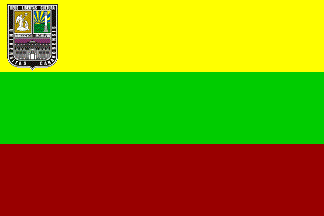
image by Ivan Sache, 6 March 2007
Historic outline: The first university in Carabobo
was created in Valencia in 1833 by a
Decree of President of the Republic, General José A. Paez, as
Colegio de Carabobo. The college was renamed Colegio Nacional de
Carabobo in 1870 by Special Decree of the President, General
Antonio Guzmán Blanco. However, the College was closed in 3
October 1874 following economical and political difficulties.
In 1880, Engineer Lino Revenga started the building of the seat
of a new university (today the Faculty of Law); on 15 November
1892, a Decree by the President, General Joaquín Crespo, created
the Ilustre Universidad de Valencia. General Cipriano Castro
closed the University by Decree on 1904. On 12 March 1915, the
Constutional President of the State of Carabobo, Emilio
Fernández, founded by Decree the Instituto Oficial de Ciencias
Políticas, named Miguel José Sanz after the founder of the
first Law College in Venezuela. On 13 December 1949, the
Institute was incorporated into the Law Faculty of the Universidad Central de Venezuela.
On 21 March 1958, Decree No 100 of the Governing Junta, presided
by Rear Admiral Wolfgang Larrazabal, (re)founded the Universidad
de Carabobo.
Symbols: The flag of Universidad de Carabobo is made of three
equal horizontal stripes, gold (symbolizing faith), green
(symbolizing liberty), and purple (symbolizing culture). These
colours are the official colours of the University; they are also
used in the three quarters of the shield of the University, which
is placed in the canton of the flag. The shield is rectangular,
in "Spanish" style with a point in base. It is made of
two upper quarters of equal size and one bigger lower quarter.
The upper left quarter depicts the Annunciation, on a golden
background representing faith. The upper right quarter represents
the column prescribed by the Cúcuta Congress to commemorate the
Battle of Carabobo. On the column is the writing "24 de
junio de 1821" (24 June 1821). The background of the column
is a sun with yellow rays in a blue sky and a green pampa. The
two upper quarters are separated from the lower quarter by a
black stripe bearing two years in Roman numerlas, MDCCCXCII
(1892, year of creation of the University by Joaquín Crespo) and
MCMLVIII (1958, year of refoundation of the University). The
lower quarter shows the facade of the former University of
Valencia, today the Faculty of Law of the University of Carabobo,
designed by Lino J. Revenga; the building is surmonted by a
purple sky. The chief of the shield bears the
motto "Deus, Libertas, Cultura" (God,
Liberty, Culture), written in white Capital letters on a blacjk
background; the lower border of the shield bears the writing
"Universitas Carabobensis", the name of the University
in Latin.
Source: <www.uc.edu.ve>.
Legislation: Chapter III of the regulation on the symbols of the
University says the colour are 'Oro, Verde y Purpura',
symbolizing faith, liberty, and culture, respectively (Article
5). The flag shall be hoisted on all buidings belonging to the
University (Faculties, Schools, Institutes, and Centers) on
Memorial Day of the reopening of the University and ceremony days
dedicated to professors, students, employees and other members of
the University (Article 7). The use of the flag in other
instances is subjected to the authorization by the Rector of the
University (Article 8).
Source: <www.rectorado.uc.edu.ve>.
Ivan Sache, 6 March 2007
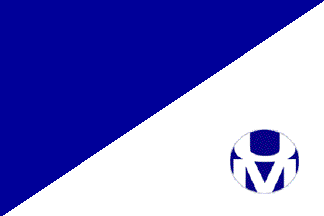
image by Ivan Sache, 6 March 2007
The flag of this university is at <www.unimar.edu.ve>
(defunct).
Dov Gutterman, 3 March 2002
The Flag of University of Margarita is dexter hoist; this is,
the hoist seen at the left of the observer and therefore the
logotype appears on the lower fly. The prevailing vexillological
custom in Venezuela is that the flags are dexter hoisted or with
the hoist sees to left of the observer. We can describe the Flag
of University of Margarita in this way: a field with approximate
ratio 2:3 diagonally divided from upper fly to lower hoist in two
stripes: blue and white, showing on this last one the logotype of
the Institution (blue circle with letters U in superior part and
M in the inferior part, both white)
Raul Orta, 3 March 2003
The University of Margarita, nicknamed "Alma Mater del
Caribe", is located on the Margarita island, state of Nueva Esparta, 38 km off the north-eastern
coast of Venezuela. This private University was founded by
Presidential Decree No 34 on 20 November 1998; it was inaugurated
on 1 November 1999.
Source: <www.unimar.edu.ve>.
Ivan Sache, 6 March 2007
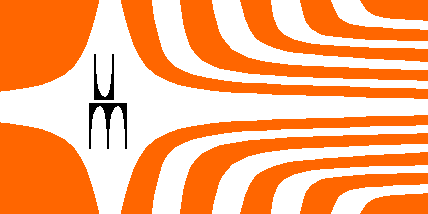
image by Guillermo T. Aveledo, 15 September 2000
Universidad Metropolitana - Metropolitan University - Caracas
Guillermo T. Aveledo, 15 September 2000
In May 1964, Eugenio Mendoza founded a civil association to
promote the foundation of a University. On 21 October 1970, the
University National Council authorized the foundation of
Universidad Metropolitana (Unimet) in Caracas. The University was
inaugurated the next day in the former seat of Colegio América
in San Bernardino. In 1976, the University moved to its current
seat in La Urbina and built a 100-ha campus. The University has
now 5,000 students and 500 professors
The University
website shows the flag of the University with a
"floating pattern". There are a few differences with
the flag shown above:
- the colour of the flag is more orange and less red
- the UM logotype is orange and not black
- there are seven upper and five lower orange "stripes"
instead of five and five.
Ivan Sache, 4 March 2007

image by Dov Gutterman, 22 July 2002
unet.gif)
The Emblem
image by Raul Orta, 26 July
2002
Based on <www.unet.edu.ve>.
Dov Gutterman, 22 July 2002
The Flag - Attributes - The National Experimental University
of Táchira is an educational entity located on the Táchira
State, at the Southwest of Venezuela. Its flag consists of a
field with approximate ratio 2:3 or square and half of length,
horizontally divided on two stripes: white the superior and blue
the inferior. The Official Emblem of the Intitution in blue to
the canton completes the conjunct.
The Emblem - Attributes and Semiology - It consist in a super
streamlined and kinetic arrange of the letters U and T that
alludes to the name of the Institution.
Source: National Experimental University of Táchira Web
Site <www.unet.edu.ve>.
Raul Orta, 26 July 2002

image by Raul Orta, 2 April 2003
unefa.gif)
image by Raul Orta, 2 April 2003
The standard and Coat of Arms of the National Experimental
Politechnic University of the Venezuelan Armed Force (Initials
UNEFA in Spanish), the former "University Politechnic
Institute of the National Armed Forces" (Initials IUPFAN in
Spanish)
1.- STANDARD - ATTRIBUTES - Consist in a regular (rectangular)
field with ratio 2:3; this is, square and half of longitude. On
its blue field gilded fringed appears the Coat of Arms of the
Institute in all its official attributes and surrounding it the
denomination "UNIVERSIDAD NACIONAL EXPERIMENTAL POLITECNICA
DE LA FUERZA ARMADA" (NATIONAL EXPERIMENTAL POLITECHNIC
UNIVERSITY OF THE VENEZUELAN ARMED FORCE) in golden roman capital
letters.
- SEMIOLOGY - Blue signs the Great Ideals, High Spirit, the
Loyalty and the Perseverance which anime the action and
activities which belongs to the Institute whilst its Coat of Arms
and denomination rebounds the privilege of the formation in its
classrooms making honor to its motto: "EDUCATIVE
EXCELLENCE".
2.- COAT OF ARMS .- ATTRIBUTES - Consist in an Spaniard shape
with only one quarter or simple Azure (blue) field which charges
an emblematic conjunct integrated by an eagle with downed wings
nascent from a tierced round shield superposed to an anchor and a
balance, with a constellation of seven five-pointed stars
disposed in arc on the chief, all in Argent (white). Border in Or
(yellow) with the inscription "UNIVERSIDAD NACIONAL
EXPERIMENTAL POLITÉCNICA DE LA FUERZA ARMADA"
("NATIONAL EXPERIMENTAL POLITECHNIC UNIVERSITY OF THE
VENEZUELAN ARMED FORCE") in gothic capital letters enameled
on Sable (black), disposed on the flanks and base of the Coat of
Arms. As external ornaments, the blazon shows a torch in Or
(yellow) flamed in the same enamel and Gules (red) disposed at
the back of the field and a pennant tierced in Or (yellow), Azure
(blue) and Gules (red) that charges as mottoes the ephemeris
"3 DE FEBRERO DE 1974" (February 3rd, 1974) and
"26 DE ABRIL DE 1999" (April 26th, 1999) in gothic
capital letters enameled in Sable (black).
- SEMIOLOGY - The field is enameled in Azure for sign the Great
Ideals, the High Spirit, the Loyalty and the Perseverance which
inspired the action and activities which belongs to the
Institute. The Constellation of seven five-pointed stars
symbolizes the Venezolanity and remembers the Constance in the
Services; by one hand and by the other, the shine of the Personal
and Professional Virtues of the Docent, Administrative and
Pupil's Personnel of the University. The central emblematic
conjunct symbolizes the union of the four components of
Venezuelan Armed Force: the round shield represents the Army; the
anchor remembers the Navy; the eagle symbolizes the Aviation and
the balance alludes to the National Guard: all enameled in Argent
for sign the Clarity, the Eloquence, the Integrity and the Truth
required of the Personnel adscript to the Institute in the
exercise of their functions The border in Or remembers the Joy,
the Constance, the Generosity and the Nobleness: virtues which
adorn who is called to conduce the destinies of the University
whilst its denomination rebound its Corporative Identity, Values,
Traditions and Objects. The torch represents the Knowledge and
the Study which encounter on the Institute's classrooms a
propitious and fecund place for its development and progress. The
pennant, reaffirmation of the Patriotic felling which encounters
echo in the Institute, shows the dates of its foundation and
elevation to the University range as a tribute to everyone who
formed and form a part of it for the realization of all that
contract its motto: EDUCATIVE EXCELLENCE for contribute
efficiently to the Progress of our Homeland.
3.- HISTÓRICAL SYNTHESIS - It was created by Colonel (Venezuelan
National Guard) MARIO MUÑOZ CABRERA. Initially was conceived for
represent INSTITUTO UNIVERSITARIO POLITÉCNICO DE LAS FUERZAS
ARMADAS NACIONALES (UNIVERSITY POLITECHNIC INSTITUTE OF NATIONAL
ARMED FORCES), which with the pass of the time was elevated to
the category that today have as UNIVERSIDAD NACIONAL EXPERIMENTAL
POLITECNICA DE LA FUERZA ARMADA - UNEFA (NATIONAL EXPERIMENTAL
POLITECHNIC UNIVERSITY OF THE VENEZUELAN ARMED FORCE).
Raul Orta, 2 April 2003
The UNEFA
official website now shows and describes a different shield . Since
there is no reason to question Raul Orta's report, it is clear
that the shield was changed. The new shield has eight stars
instead of seven and shows a portrait of Simon Bolivar; it was
therefore undoubtly adopted as a symbol of President Chávez'
Bolivarian Revolution.
The burning torch represents sport as the spirit of the
University. The eight stars represent the eight provinces of
Venezuela. The book symbolizes wisdom, perseverance and
self-abnegation in the studies. The central figure (left) is a
portrait of Simon Bolivar, representing the ideology of the
Bolivarian process. The central figure (right) represents the
four components of the armed forces. In the previous version of
the shield, there was no book and the emblem of the armed forces
was placed directly on the blue background of the shield. The
tricolor scroll bears the name of the country and the date of
foundation of UNEFA, 26 April 1999 (by Presidential Decree No
115). On the former shield, the scroll bore two dates (not shown
on the image but described in the companion text), 3 February
1974 having been deleted from the current scroll.
Ivan Sache, 7 March 2007
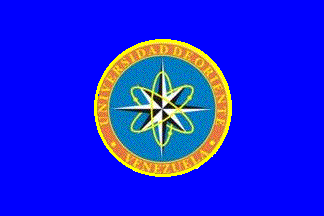
image by Ivan Sache, 30 October 2014
Universidad de Oriente (UDO) was established by Decree-Law No. 459 of 21
November 1958. Basic Course started in Cumaná (Sucre State) on 12 February 1960.
Centers were subsequently established in Maturin (Monagas State; School of
Agronomic and Oil Engineering, October 1961), Ciudad Bolívar (Bolívar State;
School of Medicine and School of Geology and Mining, 8 January 1962), Barcelona
(Anzoátegui State; School of Engineering and Chemistry, 9 January 1963), and
Nueva Esparta (Nueva Sparta State; Basic Course, 21 January 1969).
The flag of UDO is King blue with the university's emblem in the middle. The
flag shall be hoisted in the presidium at the left of the national flag.
The emblem of UDO, designed by the founding director, Dr. Luis Manuel Peñalver,
features a star shaped like a compass rose, divided into eight equal, white and
black parts, whose points indicate the points of horizon, principally the
Orient, from which raises not only the sun, but also all the stars that
symbolize Universidad de Oriente. The star is interlaced with ellipses formed by
the movement of three yellow atoms, as a representation of science, and placed
on a cyan blue disk surrounded by an orange ring bordered yellow and inscribed
with "UNIVERSIDAD DE ORIENTE" (top) and "VENEZUELA" (bottom), in yellow letters
of the Times New Roman font.
Source:
http://www.udo.edu.ve/index.php/la-universidad/simbolos-oficiales -
University's website
Ivan Sache, 30 October 2014
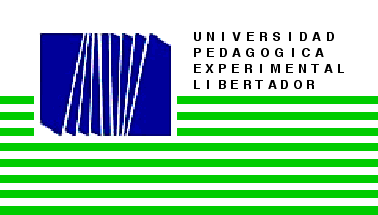
image by Ivan Sache, 10 August 2002
Universidad Pedagógica Experimental Libertador - The emblem
of the University was designed by the artist Alvaro Sotillo. It
is an abstract representation of nine books. Eight of these books
represent the eight Institutes which constitute the University,
and the ninth book represents the Rectoral Seat. In 1989, the
original grey colour of the books was changed to blue.
The flag has a white field with the emblem of the University in
upper left part and the name of the University beside it. In the
lower part of the flag, eight thin green stripes represent the
eight Institutes of the University. Green is the colour
traditionally associated to the Doctoral stuides in the UPEL.
UPEL was created by Decree #2176 of 28 July 1983 as an hommage to
Simon bolivar for the bicentenary of his birth.
Source: <www.upel.edu.ve>.
Ivan Sache, 10 August 2002
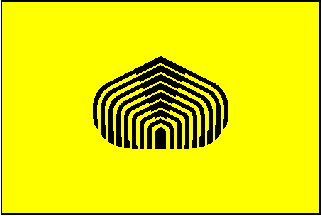
image by Raul Orta, 26 July 2002
usb.gif)
The Emblem
image by Raul Orta, 26 July
2002
Based on <www.usb.ve>.
Dov Gutterman, 22 July 2002
The Flag - Attributes - The Simon Bolivar University is an
educative entity located on Sartenejas Valley, Sucre Municipality
of Miranda State, very near Caracas. It flag consists of a yellow
field of approximated ratio 2:3 or square and half of length,
with the Institute Official Emblem in black on the center.
Historical Synthesis - The SBU flag' design was made on 1972,
when a group of professors were dedicated to the work to
conceive the elements for bring the sport delegations with an
emblem. In that opportunity, it was decided by a yellow rectangle
with the Institute's Emblem in black on the center and underneath
this one the abbreviations USB (Universidad Simon Bolivar in
Spanish). Later, on June 1987, it was decided the elimination of
the abbreviations. The official flag of Simon Bolivar University
is hoisted near to the National Flag of Venezuela, in National
and Institutional holidays, in the Benjamín Mendoza Hall:
the most important of the campus, in sport delegations, student
groupings and the Firemen Body of the Institution.
The Emblem - Attributes and Semiology - The figure is made up
with eight semicircular lines and a small rectangle placed on the
center forming a structure similar to a rounded pyramid, whose
meaning is a porch in which it's made the unity of diverse
knowledge and its projection towards the future.
Historical Synthesis - From the existing confluence between the
name "Simon Bolivar University" and its motto "the
University of the Future", the designer Gerd Leufert made
the design of the Emblem being inspired by the photographic
reproduction of an electrical circuit.
Source: Simon Bolivar University Web Site <www.usb.ve>.
Raul Orta, 26 July 2002
The logo of the University was designed by Gerd Leufert. It is
based on the photographical representation of an electrical
circuit. The logo is made of eight semi-circular lines arranged
around a small rectangle. The logo constitutes a portico which
symbolizes the unity of the different sciences and their
projection into the future. The flag of the University was
designed in 1972 by a group of professors in order to give the
sport team a flag. The first flag was yellow with the logo of the
University and its acronym USB. The acronym was suppressed from
the flag in June 1987. The flag of the University is hoisted side
by side with the Venezuelian national flag for the national and
institutional days, in the Benjamin Mendoza Hall, by the sport
teams, student associations and the fire brigade of the
University.
Ivan Sache, 10 August 2002

image by Ivan Sache, 29 July 2011
"Universidad del Zulia" (LUZ - "light" in Spanish) traces back to "Colegio
Nacional de Maracaibo", founded on 2 March 1837 by National Decree and
inaugurated on 19 April 1839. Closed in 1848 because of the political unrest,
the "Colegio" resumed its activity on 13 January 1850 with two classes in Latin
Grammar and Spanish Grammar; classes in Law, Medicine, Navigation (incl.
Cosmography, Trigonometry, Mathematics, Draftmanship and Philosophy) were added
in 1854. In 1864, the Federal Revolution transformed the Provinces into States;
the Maracaibo Province became the Zulia State and "Colegio Nacional de
Maracaibo" was renamed "Colegio Nacional del Zulia". On 17 September 1882, the
national colleges became federal colleges, so that "Colegio Nacional del Zulia"
was renamed "Colegio Federal del Zulia".
Following efficient lobbying by the Zulia Representatives Rafael López Baralt,
Francisco Eugenio Bustamante and Antonio Aranguren, the National Congress
upgraded on 29 May 1891 the "Colegio Federal del Zulia" to the "University del
Zulia", with a full university status. The new university was inaugurated on 11
September 1894. In 1897-1900, the university was directed by Francisco Eugenio
Bustamante, then considered as the best doctor and surgeon in the country, also
a liberal politician and a positivist scientist.
In 1904, the university was divided into the four Faculties of Political
Sciences, Medical Sciences, Pharmacy and Ecclesiastic Sciences. The first Gilded
Age of the university ended the same year, when the university was closed by
order of President Cipriano Castro and replaced by the "Instituto Náutico".
Castro believed that the two universities of Caracas and Mérida were enough for
training doctors,
lawyers, engineers and theologians, while technical institutes were required to
train the other students.
Oil was found in 1922 in Zulia, so that it replaced in 1926 coffee as the first
source of income in the state. A College of Political Sciences was founded in
Maracaibo on 13 August 1930 by National Decree. Its director, Jesús Enrique
Lossada, campaigned for the reopening of the University, which he eventually
obtained by a Decree of the Government Revolutionary Junta, signed on 15 June
1946. On 5 August 1946, Lossada was appointed Rector of LUZ, which then included
the three Faculties of Medicine, Engineering and Law.
Today, LUZ caters 51,600 students and 4,000 professors, spread over the three
campuses of Maracaibo, Cabimas and Punto Fijo. LUZ is organized in the 11
Faculties of Agronomy, Architecture and Design, Economic and Social Sciences,
Law and Political Sciences, Veterinary Sciences, Experimental Art, Experimental
Sciences, Humanities and Education, Engineering, Medicine and Odontology).
Source: Official website
The flag of LUZ is white with the coat of arms of the University in the upper
left corner and the letters "LUZ" in the lower right corner. White represents
the combination of the seven colors formed by light (Spanish, "luz") broken up
by a prism.
The coat of arms of LUZ was designed by Jesús Enrique Lossada, the first
director of LUZ after its reopening in 1946 - and, most probably, the inventor
of the "LUZ" abbreviation. The shield is elliptic, with a field deep sky blue
totally covered by small white clouds stretched in the horizontal direction. The
elements of the shield concur to symbolize that, in spite of 42 years of closure
and darkness, light ("luz"), truth and knowledge shine again. The shield has two
inscriptions indicating the dates of opening and reopening, and the Latin motto
"POST NUBILA PHOEBUS" (After the clouds, the sun - here personalized by the
Latin name of God Apollo).
Source: Official website
LUZ maintains a "bosque de banderas", that is a "forest of flags", made, from
viewer's left to right, of the following flags:
4. Law and Political Sciences (red)
image by Ivan Sache, 29 July 2011
5. Medicine (light yellow)

image by Ivan Sache, 29 July 2011
6. Engineering (blue)

image by Ivan Sache, 29 July 2011
7. Odontology (purple)

image by Ivan Sache, 29 July 2011
8. Economic and Social Sciences (fuchsia)

image by Ivan Sache, 29 July 2011
9. Humanities and Education (gray)

image by Ivan Sache, 29 July 2011
10. Agronomy (green)

image by Ivan Sache, 29 July 2011
11. Architecture (light blue)

image by Ivan Sache, 29 July 2011
12. Veterinary Sciences (dark yellow)

image by Ivan Sache, 29 July 2011
13. Experimental Sciences (beige)

image by Ivan Sache, 29 July 2011
14. Punto Fijo seat (water green)

image by Ivan Sache, 29 July 2011
15. Cabimas seat (salmon)

image by Ivan Sache, 29 July 2011
16. Experimental Arts (red wine)
image by Ivan Sache, 29 July 2011
Sources:
Official leaflet
Photo of the "bosque de banderas", in reverse order (that is, rear view) -
as expected, the national flag is hoisted higher than the other flags.
Ivan Sache, 29 July 2011
1)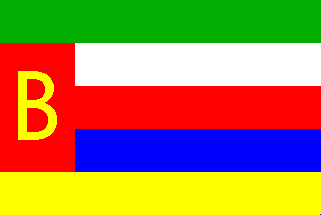
image by Guillermo T. Aveledo , 1 March 2000
2)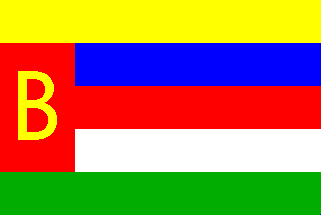
image by Guillermo T. Aveledo , 1 March 2000
Sociedades Bolivarianas Estudiantiles (Student Bolivarian
Societies) - The SBCs are societies formed throughout Venezuela's
schools in order to honour and cherish the thought and work of
Venezuela's Liberator Simon Bolivar, who led (or intervened
protagonically in) the wars of independance of six countries (or
countries to be) from Spanish rule: these countries are today's
Panama, Colombia, Venezuela (his birthplace), Ecuador, Bolivia
and Peru. These are the "bolivarian" countries (only
Venezuela has constitutionally declared itself a
"bolivarian" republic), whose flag colours serve as the
colours of the Student Bolivarian Societies flags: five stripes
of (from top to bottom or viceversa) yellow, blue, red, white and
green, with a yellow "B" on a red canton on the middle
of the hoist side, with the height of three of the stripes. These
flags are often seen in parades and on schoolyards.
I am not sure wether these flags are used in any of the other
"bolivarian" countries.
Guillermo T. Aveledo , 1 March 2000